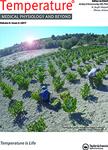版权所有:内蒙古大学图书馆 技术提供:维普资讯• 智图
内蒙古自治区呼和浩特市赛罕区大学西街235号 邮编: 010021

作者机构:FAME Laboratory Department of Physical Education and Sport Science University of Thessaly Trikala Greece Department of Nutrition Exercise and Sports August Krogh Building University of Copenhagen Denmark Human and Environmental Physiology Research Unit Faculty of Health Sciences University of Ottawa ON Canada National Critical Care and Trauma Response Centre Royal Darwin Hospital Northern Territory Darwin Australia Thermal Hyperformance Pty Ltd Takura QLD Australia Heller Institute of Medical Research Sheba Medical Center Ramat Gan and the Sackler Faculty of Medicine Tel Aviv University Israel Environmental Ergonomics Research Centre Loughborough Design School Loughborough University Loughborough United Kingdom School of Biological Sciences Georgia Institute of Technology Atlanta GA United States Department of Immunology Leibniz Research Centre for Working Environment and Human Factors (IfADo) Dortmund Germany Department of Automation Biocybernetics and Robotics Jozef Stefan Institute Ljubljana Slovenia Clinical Epidemiology Program Ottawa Hospital Research Institute Ottawa Canada College of Public Health University of South Florida 13201 Bruce B Downs Boulevard Tampa 33612 FL United States
出 版 物:《Temperature》 (Temp.)
年 卷 期:2022年第9卷第3期
页 面:227-262页
学科分类:0710[理学-生物学] 1002[医学-临床医学] 1001[医学-基础医学(可授医学、理学学位)] 07[理学] 09[农学]
基 金:Horizon 2020 Framework Programme, H2020, (34 166 167 168 169 170 171 172 173 174 175) Horizon 2020 Framework Programme, H2020 Horizon 2020, (668786) Horizon 2020
主 题:exercise heat indices heat strain hyperthermia labour Occupational temperature thermal indices work
摘 要:In a series of three companion papers published in this Journal, we identify and validate the available thermal stress indicators (TSIs). In this first paper of the series, we conducted a systematic review (registration: INPLASY202090088) to identify all TSIs and provide reliable information regarding their use (funded by EU Horizon 2020;HEAT-SHIELD). Eight databases (PubMed, Agricultural and Environmental Science Collection, Web of Science, Scopus, Embase, Russian Science Citation Index, MEDLINE, and Google Scholar) were searched from database inception to 15 April 2020. No restrictions on language or study design were applied. Of the 879 publications identified, 232 records were considered for further analysis. This search identified 340 instruments and indicators developed between 200 BC and 2019 AD. Of these, 153 are nomograms, instruments, and/or require detailed non-meteorological information, while 187 can be mathematically calculated utilizing only meteorological data. Of these meteorology-based TSIs, 127 were developed for people who are physically active, and 61 of those are eligible for use in occupational settings. Information regarding the equation, operating range, interpretation categories, required input data, as well as a free software to calculate all 187 meteorology-based TSIs is provided. The information presented in this systematic review should be adopted by those interested in performing on-site monitoring and/or big data analytics for climate services to ensure appropriate use of the meteorology-based TSIs. Studies two and three in this series of companion papers present guidance on the application and validation of these TSIs, to guide end users of these indicators for more effective use. © 2022 The Author(s). Published by Informa UK Limited, trading as Taylor & Francis Group.